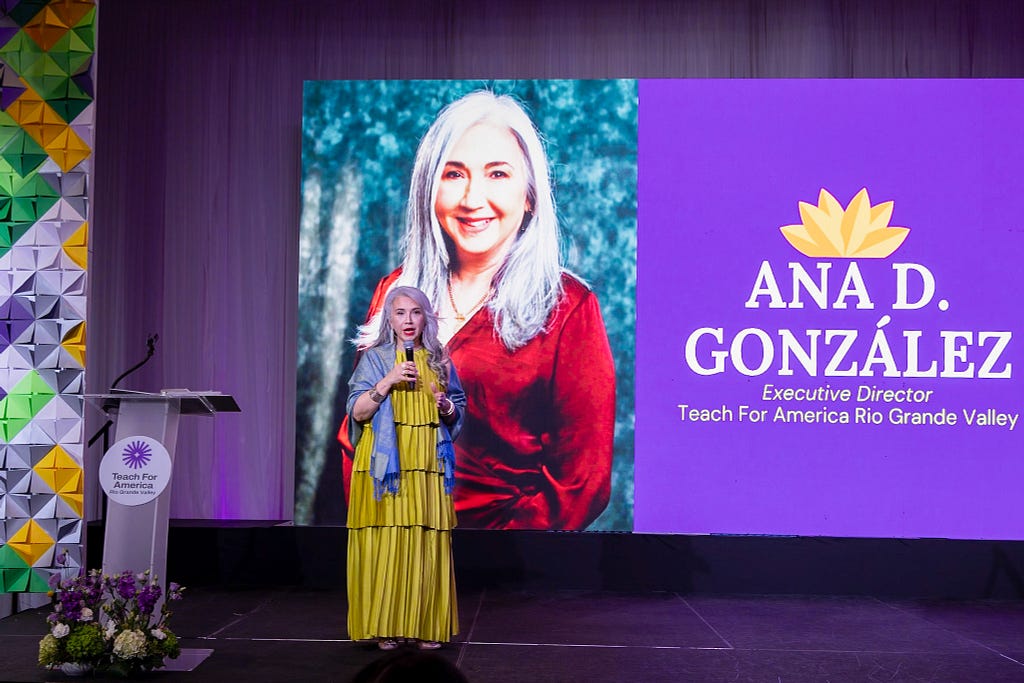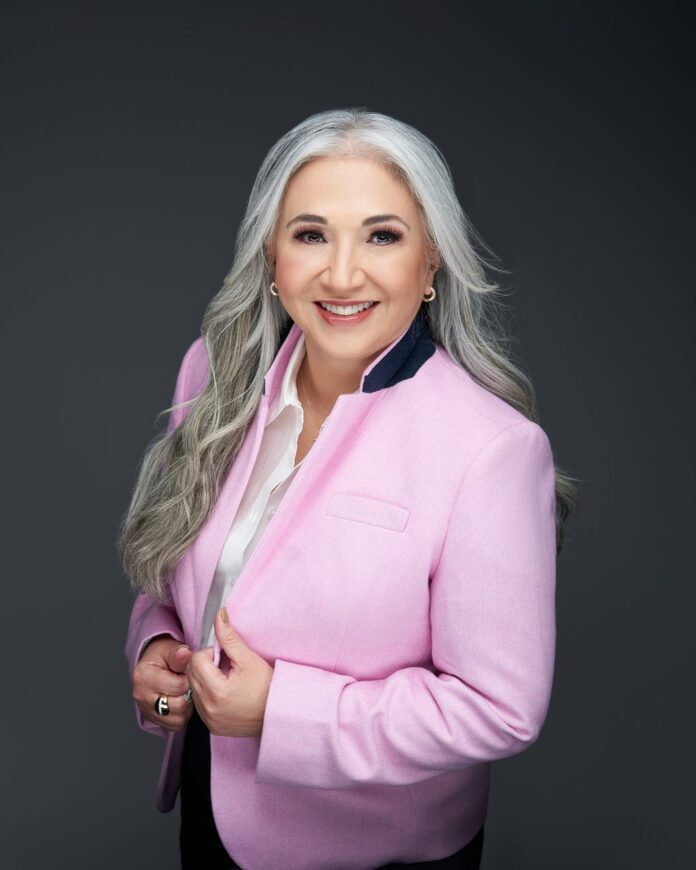Education Revolution: Ana D. González Of Teach For America Rio Grande Valley On Innovative Approaches That Are Transforming Education
Relationships are everything — Progress happens when people trust and believe in a shared vision.
The landscape of education is undergoing a profound transformation, propelled by technological advancements, pedagogical innovations, and a deepened understanding of learning diversities. Traditional classrooms are evolving, and new modes of teaching and learning are emerging to better prepare students for the complexities of the modern world. This series will take a look at the groundbreaking work being done across the globe to redefine education. As a part of this interview series, we had the pleasure to interview Ana Gonzalez. Ana Gonzalez has been an educator for almost three decades. She has served her community as a teacher, principal and district administrator before joining the Teach For America Rio Grande Valley team in 2014. She began her role at TFA as a managing director for program supporting corps members and alumni. She became executive director in 2017 and during her tenure, has led the region to attain some of the highest outcomes in corps member and alumni experiences. Ana believes that all children can reach their greatest potential when the entire community centers on what is possible for students. She continues to work towards these key academic milestones by leading in lock step with community stakeholders, which includes student and family voice as part of the regional strategy and coalition work.
Thank you so much for doing this with us! Our readers would love to “get to know you” a bit better. Can you share the “backstory” behind what brought you to this particular career path?
My journey in education began with my own lived experience. Growing up in the Rio Grande Valley, I saw firsthand how students were often discouraged from pursuing their full potential. I was fortunate to have mentors who believed in me, and that inspired me to become the kind of leader who could do the same for others. My path, from classroom teacher to principal, district leader, to Executive Director of Teach For America RGV, has been driven by a commitment to ensuring every student has access to a quality education and the opportunity to succeed.
Can you share the most interesting story that happened to you since you started your career? Can you tell us what lesson you learned from that?
One story that is most illuminating for me is starting an innovation campus from the ground up back in 2008. It was then that the T-STEM Early College High School (ECHS) was launched in the district where I was principal. It was the first of its kind in the region and the second in the state of Texas. The ECHS model affords first-generation college students the opportunity to attain up to 60 college credits or an associate degree in this case, the STEM fields, all tuition-free. The biggest lesson I learned from this endeavor is that all of our students deserve access to rigorous, high-quality educational experiences, and it takes an entire community to provide that opportunity. Our students can reach their fullest potential when the school and broader community rallies around them to support their journey and contribute to their experiences. Since the first graduating class in 2012, hundreds of students have gone on to be in high-demanding, high-wage jobs. Our community is better because of their success, and they are quickly becoming the next generation of leaders in the region who are paying it forward. Together, we can do more!
Can you briefly share with our readers why you are an authority in the education field?
I’ve dedicated my career to transforming education in the Rio Grande Valley, from leading an innovative early college high school to shaping teacher pipelines and district-wide instructional models. My work with Teach For America has allowed me to make an impact in education, and I’ve seen real results — higher graduation rates, improved teacher retention, and stronger student outcomes.
Can you identify some areas of the US education system that are going really great?
Absolutely. We’ve seen significant progress in expanding early college programs, increasing graduation rates, and integrating technology into learning. There’s also a growing recognition of the importance of social-emotional learning, which is essential for student success and teacher retention. When we support our students and teachers, the education system thrives.
Can you identify the key areas of the US education system that should be prioritized for improvement? Can you explain why those are so critical?
Supporting and retaining teachers must be a top priority. The way we train, compensate, and sustain educators directly shapes student success. Equally important is a commitment to educational excellence — ensuring that every student, regardless of background, has access to the same high-quality opportunities. Finally, we must modernize education to equip students for the future by integrating digital skills and critical thinking into our curricula.
Please tell us all about the innovative educational approaches that you are using. What is the specific problem that you aim to solve, and how have you addressed it?
Student potential is evenly distributed across all of our students; however, opportunity is not. At Teach For America RGV, we work to address this by building a high-quality teacher pipeline while ensuring that educators receive continuous coaching and support. This empowers them to make an impact at every level of education — whether leading classrooms, schools, districts, or even driving change beyond the education sector.
We also emphasize data-driven instruction with the goal of expanding access to quality education for all students.
One of our most impactful innovations is the Ignite Fellowship, a high-dosage tutoring program that provides personalized academic support to students while developing future educators. Ignite Fellows (Tutors) work virtually with small groups of students, offering targeted support in literacy and math to accelerate learning and build meaningful relationships.
In what ways do you think your approach might shape the future of education? What evidence supports this?
Our approach is shaping the future of education by simultaneously addressing immediate student learning needs and building a sustainable teacher pipeline. High-dosage tutoring, like the Ignite Fellowship, is backed by extensive research as one of the most effective ways to accelerate learning and close achievement gaps. By embedding this model within schools, we ensure that students receive personalized, small-group instruction in critical subjects like literacy and math, helping them stay on track academically.
Beyond student impact, the Ignite Fellowship is also redefining educator recruitment and preparation. By engaging college students in hands-on teaching experiences, we are cultivating the next generation of educators. Many Ignite Fellows go on to join our teaching corps, entering classrooms as full-time teachers with teaching experience and a deep commitment to student success. This innovative model strengthens the educator workforce and ensures that students have access to well-prepared teachers who are working to meet their needs.
Data from our partner schools highlights the effectiveness of this approach, with significant academic gains reported in literacy and math, increased student engagement, and a growing number of Ignite Fellows pursuing careers in
education. By combining high-impact tutoring with teacher development, we are creating a sustainable, evidence-based model that has the potential to transform educational outcomes nationwide.
How do you measure the impact of your innovative educational practices on students’ learning and well-being?
We track multiple indicators to measure the success of our program, including student academic progress, engagement, and sense of belonging. Research shows that a strong sense of belonging is a key predictor of long-term student success, fostering positive relationships with school and nurturing lifelong learners.
To ensure a comprehensive understanding of our impact, we collect data at all levels. This includes surveys from Ignite Fellows, students, and school leaders who coach the Fellows. Student and teacher feedback is just as critical as academic outcomes in evaluating success. When students feel confident in their learning and teachers feel supported, we know we are making a meaningful difference.
What challenges have you faced in implementing your educational innovations, and how have you overcome them?
Change is never easy, especially within long-standing systems. One challenge has been securing buy-in from all stakeholders: students, fellows, teachers, administrators, and policymakers. We overcome this by fostering deep relationships and demonstrating the effectiveness of our approach through data and student success stories. They say it takes a village to raise a child. In the Rio Grande Valley, we say it takes the whole Valley to raise a generation.
Keeping in mind the “Law of Unintended Consequences” can you see any potential drawbacks of this innovation that people should think more deeply about?
One risk is burnout — when we ask teachers to innovate, we must also ensure they have the resources and support they need. We have to be intentional about sustainability, making sure these initiatives don’t add extra burden but instead making teaching more effective and rewarding.

What are your “5 Things I Wish I Knew When I First Started”?
1 . Change takes time — Be patient, change is a marathon, not a sprint.
2 . Relationships are everything — Progress happens when people trust and believe in a shared vision.
3 . Data tells a story, but so do people — Listen to both the numbers and the lived experiences of students and teachers.
4 . Perfection is the enemy of progress — Start with what you have and refine along the way.
5 . Never lose sight of your “why” — The work can be challenging, but staying connected to your purpose can keep you motivated.
Can you please give us your favorite “Life Lesson Quote”? Can you share how that was relevant to you in your life?
“Life is available only in the present. That is why we should walk in a way that every step can bring us to the here and the now.” — Thich Nhat Hanh
This quote has taught me that we can achieve impact by being present with our current reality. We should be courageous to seize the opportunity now. Seizing opportunities in the present can trickle down to the next generation, but our eyes and hearts should not worry about the past and future. Our time to lead is now. This has been so relevant to me as a leader who embraces innovation and challenges in order to achieve long-lasting improvements and opportunities in the region I love and call home.
We are blessed that some of the biggest names in Business, VC funding, Sports, and Entertainment read this column. Is there a person in the world, or in the US, with whom you would love to have a private breakfast or lunch, and why? He or she might just see this if we tag them 🙂
I would love to grab breakfast or lunch with Josephine Chen who sits on the Seed/Early team at Sequoia. I love her personal story and gumption for what is possible through innovation, particularly healthcare and the intersection of it with education. I live in a high poverty area where healthcare access is scarce for many families, including our students, many of whom live in multi-generational households and in rural communities. Securing healthcare and having access to affordable resources is a key indicator for how our families and students fare in their life and academic journey. No child should suffer from lack of foundational services that puts them on better learning and life-long trajectories.
How can our readers further follow your work online?
You can follow Teach For America Rio Grande Valley on Instagram, Facebook, and LinkedIn @TFARGV!
Thank you so much for these insights! This was so inspiring!
Education Revolution: Ana D González Of Teach For America Rio Grande Valley On Innovative… was originally published in Authority Magazine on Medium, where people are continuing the conversation by highlighting and responding to this story.


